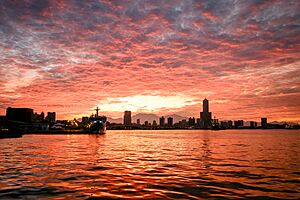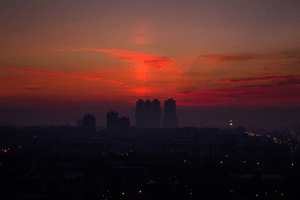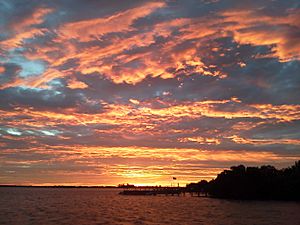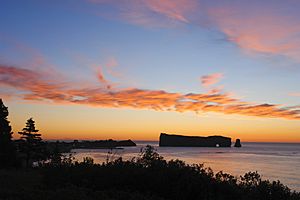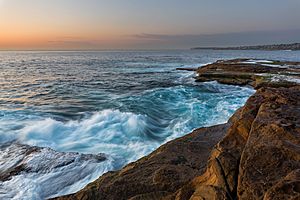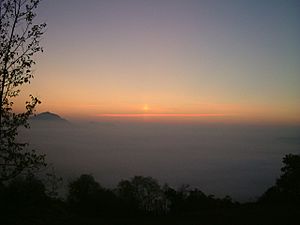Sunrise facts for kids

Sunrise is the special moment in the morning when the top edge of the Sun first appears on the horizon. It's also called Sun up.
This term can also describe the whole process of the Sun rising and all the cool light effects that happen in the sky at that time.
Contents
What Does "Sunrise" Mean?
Why the Sun Seems to "Rise"
Even though we say the Sun "rises" from the horizon, it's actually the Earth that is moving! Our planet spins, and that spinning makes the Sun appear to come up over the edge of the world.
When Sunrise Really Happens
For scientists, sunrise is just one quick moment: when the very top of the Sun touches the horizon. But when most people talk about "sunrise," they mean a longer time, both before and after this exact moment.
- Twilight is the time in the morning when the sky starts to get bright, but the Sun isn't visible yet. The very start of morning twilight is called astronomical dawn.
- The period after the Sun has fully risen, when you can still see amazing colors and light effects in the sky.
How We Measure Sunrise
The Angle of the Sun
Sunrise actually happens a little before the Sun truly reaches the horizon. This is because Earth's atmosphere bends the Sun's light. This bending of light is called atmospheric refraction. It makes the Sun look like it's higher than it really is.
Also, for sunrise, we look at when the Sun's top edge appears, not its center.
When Does Sunrise Happen?
The time of sunrise changes throughout the year. It also depends on where you are on Earth, like your longitude and latitude, how high up you are, and your time zone.
These changes happen because:
- The Earth is tilted on its axis.
- The Earth spins every day.
- The Earth moves in an oval-shaped path around the Sun each year.
- The Earth and Moon also move around each other.
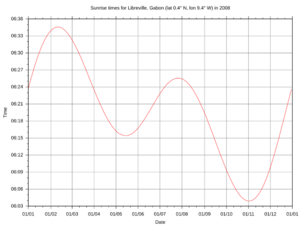
In late winter and spring, sunrise happens earlier each day in many places. It reaches its earliest time around the summer solstice (the longest day of the year). After that, sunrise starts to happen later each day, reaching its latest time around the winter solstice (the shortest day of the year).
What Sunrise Looks Like
Amazing Colors
When white sunlight travels through Earth's atmosphere, tiny air molecules and particles in the air scatter the light. This scattering is why we see different colors.
As sunlight comes towards us, some colors are scattered away by these tiny particles. Colors with shorter wavelengths, like blue and green, scatter more easily. This means they are removed from the light beam first.
At sunrise and sunset, the sunlight has to travel through more of the atmosphere to reach our eyes. Because the blue and green light are scattered away almost completely, we are left with the longer wavelength colors: orange and red. These red and orange colors can then be scattered by clouds and other larger particles, making the horizon glow with these warm colors.
Colors at sunset are usually brighter than at sunrise. This is because the evening air often has more tiny particles in it than the morning air.
Sometimes, ash from volcano eruptions can affect sunrise colors. If the ash is high up in the stratosphere, it can create beautiful glows before sunrise, called "pre-sunrise glows." For example, after the eruptions of Mount Pinatubo in 1991 and Krakatoa in 1883, amazing glows were seen around the world! These high clouds reflect the reddened sunlight back down to Earth.
Cool Optical Illusions
- Because of atmospheric refraction (light bending), we can see the Sun even when it's still below the horizon.
- Light from the bottom edge of the Sun bends more than light from the top edge. This makes the Sun look a bit squashed or flatter when it's just above the horizon. Its width doesn't change, so it looks wider than it is tall.
- The Sun often looks bigger at sunrise than it does when it's higher in the sky. This is similar to the Moon illusion.
- It seems like the Sun rises and moves around the Earth, but it's actually the Earth that is spinning! The Sun stays in place. We feel like the Sun is moving because we are on a spinning planet.
- Sometimes, a false sunrise happens. This is a special type of Parhelion, which is a kind of halo around the Sun.
- Very rarely, just before sunrise or after sunset, you might see a green flash. This is a quick green spot that appears above the Sun, usually for only a second or two.
Images for kids
See also
 In Spanish: Orto para niños
In Spanish: Orto para niños


